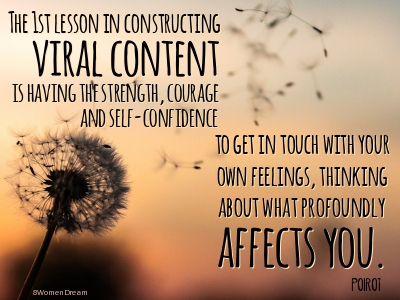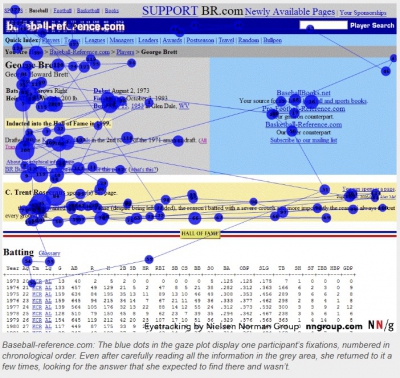Last updated on June 4th, 2018 at 06:42 pm
 Are you sharing your big dream online and confused as to how to make your content go viral? I’ve been thinking a lot about confusion. It’s most likely because I am helping care for a parent with Alzheimer’s disease. Never has it been so painful to watch how confusion can mess with your reality and your ability to live a successful, independent life.
Are you sharing your big dream online and confused as to how to make your content go viral? I’ve been thinking a lot about confusion. It’s most likely because I am helping care for a parent with Alzheimer’s disease. Never has it been so painful to watch how confusion can mess with your reality and your ability to live a successful, independent life.
I also see how confusion can prevent you from making good choices and how uncertainty can hold you back.
When you share content online, you assume that viewers will understand your vision, when many are misinterpreting what you are trying to convey. The ability to understand your content can be clouded by unfamiliar slang expressions, your writing style, what is occupying the viewer’s mind, site distractions, and the timing of when you promote it.
Corporate trainers learn how students get confused right away (I used to be one) on the job. While teaching the first training class in a series, quite often the course-ware and the order of the training will need to be changed before the next training session due to students’ confusion over materials that don’t make sense to them in practice.
The confusion stems from assumptions made by the course developer about how the students will understand the topic and use it. Content creators too often create data without the end-user in mind.
Creators tend to do what CREATORS like.
The same can be said for launching your dream online, be it a blog, business website, or an e-commerce site to sell shoes. The problem is that you think too small; focus on the wrong element, or you make decisions based on out-of-date information. You then scratch your heads when no one seems to be paying attention.
Case in point: dreamers who blog to launch their dream.
When many of you were in school, you were taught a style of writing that was intended for print publication, whether it was for research papers, historical novels, creative writing, or a particular journalistic style. You may remember such phrases as “expository writing” or “narrative writing” along with “APA”, “MLA,” and “URM.” As you shudder at the thought of writing a research paper in MLA style, you should know that schools still teach these writing methods while ignoring the obvious: how to write for the Internet.
Because the Internet is a rather odd creature and it doesn’t follow many of the old English rules.
How Viewers Read Online

Viewers scan online content more than they read line-by-line. They are easily bored and distracted. They want information right now. Website visitors are not like a customer who has just purchased a hard-copy book from the bookstore then races home to curl up in a corner and spend the afternoon digesting the entire book from cover-to-cover.
Reading on a computer screen is hard on the eyes, so online content must draw the reader in from the beginning with a descriptive title, or they click away to another website.
Staring at a computer screen is tiring, so the critical content must be easy to find, exciting, or make them laugh, or POOF they’re gone.
You have about 4 seconds to enthrall them.
With so many choices on the Internet, visitors move on to the next site and start over. Haven’t you done the same?
A big part of the problem is that the search tool the visitor used to find a particular answer to their inquiry didn’t deliver them to a site that produced what they expected to see. The perfect answer to their question, or solution to their problem, is somewhere on the Internet — and the content developer who created the page you landed on used your search term to describe and offer something that doesn’t match what you meant to see.
Confused?
Just like that student-content disconnect that appears for trainers on the first day of new training, the same thing happens with Internet content every single day because too many people don’t understand how to write for the Internet. What they do provide often adds to the confusion online.
I can hear all the writers (artists) groaning at the thought of this and misunderstanding what “writing for the Internet” means.
Ever want to see how much your writing misses the mark? Take a two-word phrase that best describes something you’ve written about and run it through Google Keyword Planner Tool and see how many people also use that same term. Try it. You may discover that the keyword search term you use to describe your story isn’t a term people search for online–at all. Or the word means something different to everyone else but you.
Here’s where I hear:
“But I like my phrase better!”
“My phrase is more clever.” (thus they think will attract attention when shared with friends on social media).
“Using the search engine phrase inmy content/title/description/image feels unnatural.”
The reason content writers say this is because they are stuck in what they learned in school writing for teachers and they are confused how the Internet works. They believe a sizeable viral reaction stems from when something they publish and gets shared with family and friends.
Creating titles and opening paragraphs like you learned in school leads to confusion for the person who is searching for specific content on the Internet. It’s not print media.
How Online Content Delivery Happens
When publishing content online, your content (once its published) has the shelf life of about a day–the day you spend sharing it with family and friends. Maybe it goes around Facebook a bit. Then it’s done. For life.
Unless you’ve used a search term in your title, your description, and in a couple of places in your content which best describes your items so that it becomes found through search engines in the future, it will never have a chance to go viral.
It’s in the finding and sharing of your content by influencers (people with a large social media following or web presence) who provide you with the opportunity to be seen by the masses.
Viral content is usually discovered by an influencer long after the item was first posted. Often, the influencer has a large, trusted following that when he or she shares interesting finds online, they go viral. Once they find and share your online content, your content tends to be viewed by more people exponentially.
Content doesn’t become viral because the person who created it publishes it and shares it with family and friends.
Content becomes viral when someone with influence finds it through search and decides to share it in their sphere of influence. And they wouldn’t have found that particular content if the search hadn’t delivered something back relating to their specific search phrase.
It’s the search phrase and your title that brings the influencer to your content for the first time. To better illustrate what I am trying to explain, I’ll share BuzzFeed’s Publisher Dao Nguyen’s TED video on the reasons content goes viral.
What Makes Something Go Viral?
Once the influencer arrives from search to view content–it had better be unique, unexpected, entertaining, or educational–about what they hope to find (or all of the above) or he or she will click off this page just as fast as they arrived.
Now if you are already famous or have a huge marketing budget to buy your search placement then you can ignore how the Internet works.
But for the rest of us living our dreams online and hoping for viral content to get your big dreams in front of the right people, you’ve got to publish with how the Internet works in mind
Catherine Hughes
Want viral content?

Catherine Hughes is an accomplished magazine columnist, content creator, and published writer with a background as an award-winning mom blogger. She partners with companies to create captivating web content and social media stories and writes compelling human interest pieces for both small and large print publications. Her writing, which celebrates the resilience and achievements of Northern California’s residents, is featured in several magazines. Beyond her professional life, Catherine is passionate about motherhood, her son, close friendships, rugby, and her love for animals.
Note: Articles by Catherine may contain affiliate links and may be compensated if you make a purchase after clicking on an affiliate link.





